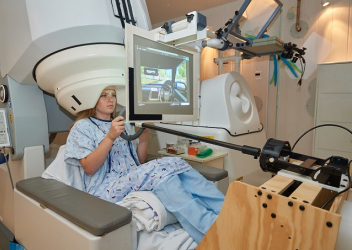Research In Action
Research In Action
Breadcrumb

The Neuroscience of Driving Research team at Children’s Hospital of Philadelphia (CHOP) recently published a paper in Human Brain Mapping that advances the field. The research validates a new approach to measure the complex integrated brain function needed to drive using whole brain Magnetoencephalography (MEG) neuroimaging and simulated driving.
The field of neuroscience has traditionally relied on the use of simplified tasks of isolated brain functions, such as pressing a button in response to a visual or auditory cue (or both) following a pre-established rule. These tasks, however, do not capture the brain's ability to handle complex real-world tasks, such as driving, that rely on the integration of multiple systems in the brain (sensory, motor and cognitive) and in-the-moment responses to a changing environment.
Safe driving requires this integrated brain function, which allows for vehicle control (steering, pedals and controls), good situational awareness, management of distractions, and the ability to make quick decisions and respond rapidly in critical moments to avoid crashing.
Assumptions Hold True
For the study we scanned the brains of 23 healthy 16- to 23-year-olds who completed a custom-built repeated-trials driving scenario. To validate our new approach to measure complex integrated brain function, we assumed that when participants use their foot to push the car pedals for gas and brake, this would elicit expected changes in typical primary motor cortex neural responses associated with foot movement (i.e., beta-event-related desynchrony, B-ERD, and movement-related gamma synchronization, MRGS).
We also wanted to confirm that this novel approach is even more useful for studying complex motor function that requires top-down cognitive control, such as planning and executing a stop (via braking) in response to a red traffic light at an upcoming intersection. To do so, we assumed that these more complex parts of the driving task could also probe frontal-lobe cognitive control responses (specifically, Frontal Midline Theta: FMT).
The study results not only support these assumptions and validate this new approach, but also go a step further by providing evidence that we can see trial-by-trial changes in driving performance. These changes simultaneously reflect how the brain responds to them, suggesting that we can now see the mechanism of learning or improved performance over time during the driving simulation. This is a rare finding in the field of neuroscience studying motor learning at the neural level.
This approach offers a path forward for better understanding of integrated cognitive-motor processes and more real-world motor tasks, in typically developing and clinical populations, and I look forward to continuing this research in partnership with the CHOP Department of Radiology Lurie Family Foundation MEG Imaging Center, the Annenberg Public Policy Center at the University of Pennsylvania, and the Center for Child Injury Prevention Studies (CChIPS).




